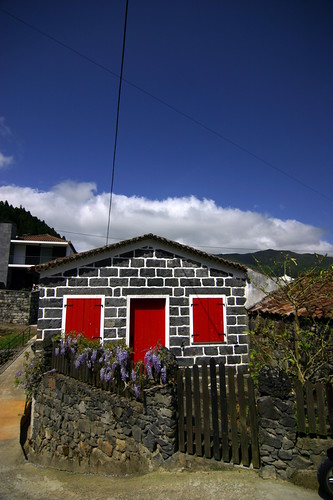Torresmos de porco (small browned rashers of bacon), morcela (blood pudding), linguiça com inhames (Portuguese sausage with yams) and molha de carne (a meat speciality) are the main dishes of a cuisine which, with caldo de peixe (fish soup), polvo guisado em vinho (octopus stewed in wine) and bolo-de-milho (prepared with maize), delights ail hearty eaters. Those who like shell-fish will find worthy companions for their appetite in the local lobsters, deep-water crabs and cavacos. The soft, white fresh cheese of Pico is a good start to a meal, which can end with the typical, delicious cheese of São João, with its yellow rind, soft interior and intense smell, produced from cow's milk.
Massa sovada, rosquilhas, vésperas and arroz doce are the typical sweets of the island, connected with the Holy Ghost Festivals. They are completed by the Carnival sweets, the filhoses, coscorões and sonhos. Fig and local brandies, made in old copper stills, are digestive beverages that are much appreciated. For those who like sweet drinks, Pico can offer the typical angelica.
A famous "verdelho"
Born on the soil of lava, protected from the wind by walls of rough, dark stone, warmed by the rays of the sun, the bunches of grapes acquire the sweetness of honey. Squeezed, they produce a dry white wine with an alcoholic content of 15 to 17 degrees which, after ageing serves as an excellent appetiser. In the last century it was exported to many countries in Europe and America and even reached the tables of the Russian Court. The vineyards, which mark the landscape of the island, also produce a dry, fresh, light and fruity wine that is the ideal companion of a dish of shell-fish or fish, and also the red vinho de cheiro whose presence is compulsory on tables on feast days.
The orchard island
The ground made of lava, the sun and the dry climate make Pico the orchard of the Azores, where apple and pear trees, damson and peach trees, plum and orange trees flourish and produce sweet, juicy fruits that are taken early in the morning on the fruit boats to the town of Horta by the men and women who sell them there. But it is the figs, with an interior that is as red as rubies, a true delicacy for gourmets, that best symbolise the delicious fruit of Pico.
Massa sovada, rosquilhas, vésperas and arroz doce are the typical sweets of the island, connected with the Holy Ghost Festivals. They are completed by the Carnival sweets, the filhoses, coscorões and sonhos. Fig and local brandies, made in old copper stills, are digestive beverages that are much appreciated. For those who like sweet drinks, Pico can offer the typical angelica.
A famous "verdelho"
Born on the soil of lava, protected from the wind by walls of rough, dark stone, warmed by the rays of the sun, the bunches of grapes acquire the sweetness of honey. Squeezed, they produce a dry white wine with an alcoholic content of 15 to 17 degrees which, after ageing serves as an excellent appetiser. In the last century it was exported to many countries in Europe and America and even reached the tables of the Russian Court. The vineyards, which mark the landscape of the island, also produce a dry, fresh, light and fruity wine that is the ideal companion of a dish of shell-fish or fish, and also the red vinho de cheiro whose presence is compulsory on tables on feast days.
The orchard island
The ground made of lava, the sun and the dry climate make Pico the orchard of the Azores, where apple and pear trees, damson and peach trees, plum and orange trees flourish and produce sweet, juicy fruits that are taken early in the morning on the fruit boats to the town of Horta by the men and women who sell them there. But it is the figs, with an interior that is as red as rubies, a true delicacy for gourmets, that best symbolise the delicious fruit of Pico.




No comments:
Post a Comment